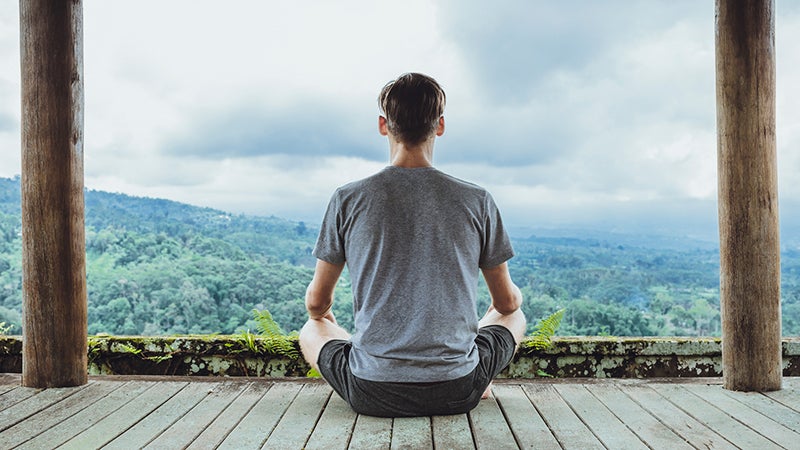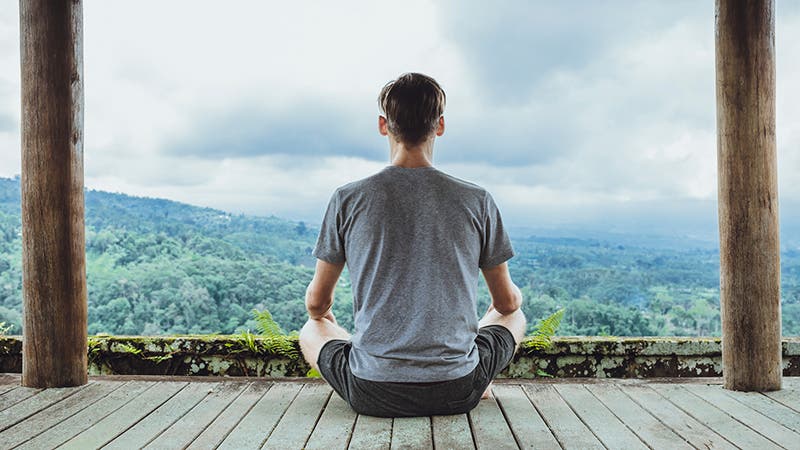Awaken Your Yoga Practice with Breathing Awareness


Yoga gives us deeper breathing awareness–and brings greater concentration to the parts of the body that allow us to exhale and inhale fully.
Until you start doing yoga, you may never pay much attention to your breath. But with the coaching of yoga teachers—or perhaps just because of your new awareness of your body—you start to see all the ways your breath can vary. Is it quiet or noisy, heavy or soft? Where does it originate and how does it move through you? Is it relaxing, energizing, or making you tense? Helping or hindering your asana practice?
Yoga teaches that the breath exerts a powerful influence on the body and mind–and vice versa. When you’re tense or guarded, for example, you may first hold the breath and then take fast, shallow breaths. Relaxed breathing is slower and softer, and has a steady, even pattern. This deep, slow, relaxed breathing, used in Savasana (Corpse Pose) and other restorative poses, is most commonly associated with yoga. But to supply oxygen to the hardworking muscles in an active series of poses like Sun Salutations, we also need a faster deep breathing pattern. And most subtle of all is the finely controlled deep breathing of Pranayama. For best results, all three patterns require openness of the breathing space (the rib cage and abdomen) and fine coordination of several muscle groups.
See alsoFeel the Feels: A Mindful Breathing Practice for Tough Emotions
Understanding the Anatomy of Breathing
The diaphragm muscle in the middle of the torso is a key player in establishing the pattern of the breath. Stretching like a drumhead across the bottom of the chest, the diaphragm separates the heart and lungs above it from the abdominal cavity and digestive organs below. The muscle fibers then extend inward toward the middle of the body and gather into a central tendon that doesn’t attach to the skeleton.
When relaxed, the diaphragm curves upward like a dome. When it contracts, it shortens and flattens, pushing on the digestive organs below and lengthening the chest cavity above. This expansion of the chest cavity draws air into the lungs. The lungs have no capacity to expand or contract on their own. They simply respond to the size and shape of their container, the chest cavity. When it expands, the lungs inflate and air rushes in to fill the vacuum. When the container shrinks, the lungs are compressed and air is pushed out.
To feel the action of the diaphragm, lie on your back. The belly needs to be completely soft and relaxed, so it may be helpful to put some support under your knees. Now place your hands on your belly and feel the movement of your breath. In relaxed diaphragmatic breathing, your hands should softly lift on the inhalation. As the diaphragm relaxes, it returns to its dome shape and the belly softly drops.
In order to take a full breath, the diaphragm and several accessory muscles must work in concert to expand the rib cage in all directions. The accessory muscles include the sternocleidomastoids, which form a V-shape on the front of your neck, extending from the top of the sternum and collarbones up to the base of the skull just behind your ears. It’s easy to see them work.
Stand in front of a mirror with your neck uncovered. Near the end of a deep inhalation you’ll see the sternocleidomastoids contract. They lift up on the rib cage as the diaphragm lengthens the chest cavity from below. This chest cavity expansion is also assisted by the intercostals, three layers of small muscles that span adjacent ribs. As they contract, they lift each rib up and away from the center of the body, providing both vertical and lateral expansion of the chest cavity. To feel this for yourself, stand and wrap a long, soft belt or tie around your lower ribs, about three to four inches above where you normally belt your pants. Cross the belt ends in front and hold one end in each hand. As you exhale and the rib cage compresses, pull the belt tight; as you inhale, feel the belt expand as the rib cage opens up and out. This expansion is created by the combined action of the diaphragm and intercostals. You can use this exercise with the belt to increase lung capacity and help expand the rib cage in preparation for pranayama.
See alsoTune in to Your Breath in Meditation to Find Inner Peace
You also need strong back muscles to help you take a deep breath. Your spine forms a strong column that supports the expansion of the ribs up and out, with the erector spinae muscles running up each side of the spine, acting like guy wires to support the spine and rib cage. When you are curved over in a slump, with a forward head and a collapsed chest, your posture significantly limits your ability to breathe deeply. The collapsed chest puts pressure on the diaphragm, limiting its ability to function, and also hampers the expansion of the ribs. Breath movements can also be limited by short and tight abdominal muscles. Chronic pain in the lower back, pelvis, or abdomen can also affect breathing patterns by causing guarding and holding in the diaphragm and abdominal muscle layers. In fact, most pain, chronic or acute, is accompanied by abnormal breathing patterns. When I work with a client in pain, I often begin with breath awareness.

Release Into Your Practice With Better Breath
Yoga can help improve your breathing patterns, and good breathing patterns can immeasurably improve the quality of your yoga practice. Whether you are practicing quiet, relaxing poses like forward bends, energizing poses such as Sun Salutations, or the subtle techniques of pranayama, one of the most important steps to improve your breathing is to free the movement of the diaphragm by opening the chest and upper abdomen.
Since it’s much more challenging to open the chest while standing or sitting, you’ll do best to begin lying down. Lie on your back lengthwise on a bolster. Your hips should be on the floor, with the end of the bolster supporting your lowest back ribs, just above your waist. The bolster’s support will open space for the diaphragm to contract and relax without constriction.
Put a folded blanket or small firm pillow under your head so that your chin is a little lower than your forehead. This head position will help direct your focus inward, so that your attention can center on your breath. As you relax and settle down onto the bolster, notice that your breathing becomes slower and smoother. Your belly should softly rise and fall with each breath. This quality of relaxed, slow, and smooth breathing indicates relaxation of the nervous system; you can use it to facilitate the release of muscle tightness in stretching poses like forward bends and supported backbends.
You may be able to feel your rib cage expanding softly up and out as the diaphragm and intercostals work together to expand the chest cavity with each inhalation. This chest expansion is the primary action needed in pranayama; the abdomen should remain quiet, with most of the increase in volume occurring in the rib cage. Most of us need many months or years of practice to make this breath pattern smooth and nearly effortless.
See alsoAnatomy 101: How to Tap the Real Power of Your Breath
Now bring your attention to the exhalation. During demanding physical activity, the breathing rate increases. Air must be pushed out of the lungs quickly to make room for more incoming air. The abdominals and some intercostals contract to help compress the chest cavity and squeeze air out.
During quiet, relaxed breathing, however, no squeezing is necessary. As always, we use muscular energy to expand the lungs, but during relaxed exhalation the air is simply pushed out of the lungs by the elastic recoil of the rib cage. The abdominals, along with all the muscles of respiration, can release completely during a relaxed exhalation.
As you become more deeply relaxed and your breathing becomes quieter, see how little effort you can use on each inhalation. Let exhalations become virtually effortless, so that each one provides an opportunity to completely relax. Relaxed, open, and centered, you are now perfectly prepared to begin Savasana, pranayama, or meditation.
About our writer
A licensed physical therapist and certified Iyengar Yoga teacher, Julie Gudmestad runs a private physical therapy practice and yoga studio in Portland, Oregon. She regrets that she cannot respond to correspondence or calls requesting personal health advice.